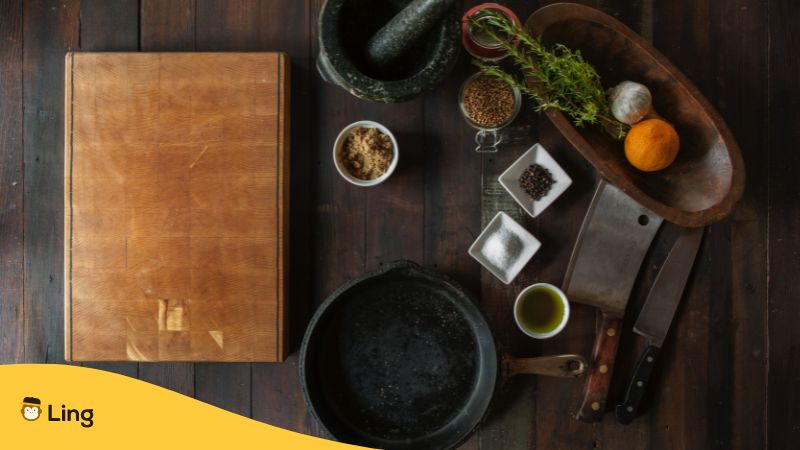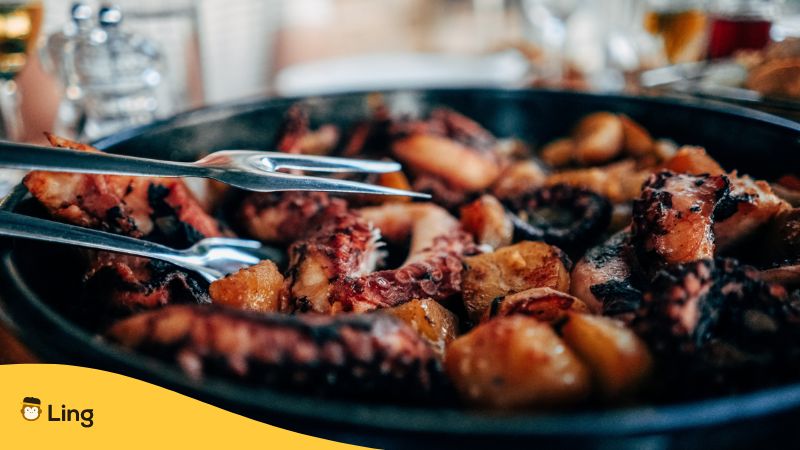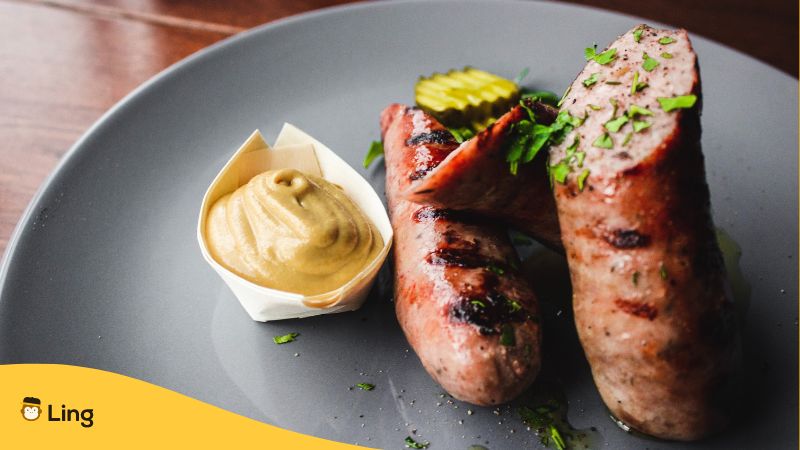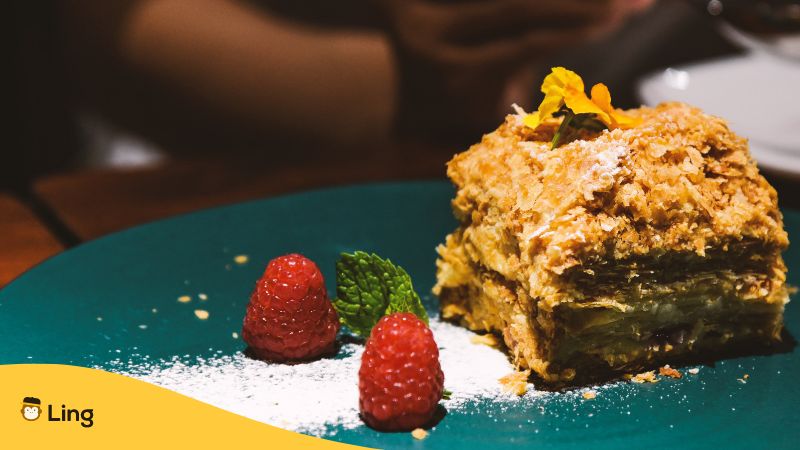Croatian cuisine is full of flavors that will make your taste buds dance! Whether you’re trying a traditional dish or new trendy foods, knowing the Croatian vocabulary for flavors will help you order like a pro.
In this guide to flavors in Croatian, we’ll cover some of the most important flavor words to help you navigate the menu like a native speaker & impress your Croatian friends and families. Let’s learn more Croatian words and phrases right now!

Basic Croatian Flavor Vocabulary
Let’s start with some basic Croatian vocabulary for flavors. In Croatian, the word for flavor is “okus.” Here are some common flavor-related words and phrases to help you navigate a Croatian menu:
- Slano – salty
- Slatko – sweet
- Kiselo – sour
- Gorko – bitter
- Začinjen – spicy
- Ukusno – tasty
- Neukusno – tasteless
- Kremasto – creamy
- Jako ukusno – delicious
These words are a great starting point for describing the flavors in Croatian dishes. For example, if you’re trying “pašticada”, you might describe it as “kremasto” (creamy) because it’s often served with a rich sauce. Or if you’re trying “ćevapi”, you might describe them as “začinjen” (spicy) because they’re often seasoned with paprika.
Let’s go a bit more in-depth and discuss two of the most common flavors used in Croatian cooking!
Two Croatian Flavors That Dominate Croatian Cooking
One flavor that is commonly used in Croatian cooking is “ljuto,” which means spicy. As seen above, there is also the word ‘začinjen’ meaning spicy. If you’re a fan of spicy food, you’ll love Croatian food! From ajvar to čevapi, there’s no shortage of spicy, traditional Croatian dishes here to try. Just be careful not to overdo it, or you might end up with a case of “ljutina” (spiciness)!
Another flavor that is popular in Croatia is “umami.” This flavor is often described as savory or meaty and is commonly found in foods like mushrooms, tomatoes, and cottage cheese too. In Croatian, you would say “umami” just like in English. Smoked sausages, sour cream, goat cheese … Croatian dishes are packed with umami, enough to get your mouth watering just thinking about it!

More Flavor Words Found On A Croatian Food Menu
Now that we’ve talked about the basics, let’s dive into a Croatian food guide for 5 more flavor words that you might encounter on a Croatian menu:
- Ajvar – This is a popular sauce made from roasted red peppers and eggplant. It’s usually served as a condiment commonly served with grilled meats or bread. It’s slightly sweet and tangy with a smoky flavor.
- Češnjak – Garlic. If you’re a garlic lover, you’ll be happy to know that it’s a popular ingredient in Croatian cooking. You’ll find it in everything from soups to marinades.
- Med – Honey. Croatia is known for its delicious honey, which comes from the many beekeepers around the country. It’s often used to sweeten desserts or as a glaze for meats.
- Maslinovo ulje – Olive oil. This is a staple ingredient in Mediterranean cuisine, and Croatia is no exception. You’ll find it drizzled over salads, used in marinades, and as a dip for bread.
- Šljivovica – Plum brandy. This is a popular Croatian liquor that’s often served as an aperitif or digestif. It’s made from fermented plums and has a strong, fruity flavor.

History Of Croatian Cuisine & Traditional Croatian Foods
Croatia has a rich history with food, as influenced by its location near the Mediterranean Sea! The region’s proximity to the Mediterranean has heavily influenced Croatian regions and their cuisine, and you can see this influence especially in the liberal use of olive oil, seafood, and aromatic herbs.
In addition to Mediterranean influences, Croatian foods also has strong ties to neighboring countries like Italy, Austria, and Hungary. These influences can be seen in dishes like “štrukli,” a type of cheese pastry that is similar to Italian cannelloni.
Each culture and country brought their own culinary traditions, which have merged with the local Croatian ingredients to conjure a magical palate! By the way, of the following dishes are best served with fine Croatian wine!

Yet, despite these outside influences, Croatian cuisine has a distinct cooking method and flavors that is unique to the region, and create their own Croatian version. One of the most famous Croatian dishes is “pašticada,” a beef stew cooked slowly originating in the gorgeous coastal city of Dubrovnik. The flavors are magnificent, with red wine, prunes, cinnamon, cloves, and nutmeg. This dish is typically served with homemade pasta or gnocchi (Italian influence!) and is a must-try for anyone visiting Croatia.
Another classic Croatian dish is “ćevapčići,” small sausages made from a mixture of beef and lamb. They are usually served with a side of ajvar, a spread made from roasted red peppers, eggplant, and garlic.

Croatian cuisine is also known for its fish dishes, thanks to the country’s long coastline. Some of the most popular seafood dishes include “brudet,” a fish stew made traditionally served with sliced onions,, tomatoes, and red wine, and “black risotto,” a creamy dish made with squid ink and Arborio rice.
If you’re on a budget and love exploring street food, then you should try “ćevapi,” which are grilled meat skewers that are often served with onions, ajvar (a spicy pepper spread), and a side of fries. Try this delicious meal from one of the many food vendors that line the streets of Croatia at night.

Finally, let’s talk about Croatian desserts. Croatian cuisine has a sweet tooth, and there are plenty of delicious desserts to choose from. One classic Croatian dessert is “kremšnita,” a creamy vanilla and custard pastry that is similar to a Napoleon. A common street food dessert is “fritule,” which are small, fried doughnuts that are often flavored with rum or citrus and lemon zest. This Croatian pastry is delectable!
In conclusion, Croatian food is a delicious and diverse mix of flavors and influences. Whether you’re a fan of spicy food, savory pie, or sweet desserts, there’s something for everyone in Croatia. So the next time you’re out to eat, impress your friends by ordering your meal in Croatian and try traditional Croatian food. And who knows, you might just discover your new favorite dish!
Final Tip: If you’re feeling adventurous, try some of these Croatian specialties:
- Octopus salad – This refreshing dish is made with tender octopus, tomatoes, and onions, all tossed in a lemony dressing with olive oil. It’s perfect for a hot summer day.
- Peka – This is a traditional Croatian dish made by slow-cooking meat and vegetables under a bell-shaped dome. The dome is covered with hot coals, which cook the food to perfection.
- Rožata – This is a sweet custard dessert that’s similar to crème brûlée. It’s flavored with lemon and caramelized sugar on top.

How To Order At A Croatian Restaurant
Now that we’ve explored some of the history and flavors of Croatian food, let’s talk about how you can use these words and phrases to order a Croatian specialty in a restaurant. If you’re feeling adventurous, you might try asking your waiter for a recommendation. Here are examples of phrases to use at a restaurant:
- Dobar dan! – Good day!
- Mogu li dobiti preporuku za nešto ukusno? – Can I get a recommendation for something good?
- Što preporučujete? – What do you recommend?
- Da li je ovo jelo slano? – Is this dish salty?
- Želim nešto slatko. – I want something sweet.
- Molim vas, bez pikantnih jela. – Please, no spicy dishes.
And finally, if you really enjoy your meal, you might want to compliment the chef. Here’s how you can say “delicious” in Croatian:
- Ovo jelo je jako ukusno! – This dish is very tasty!
So there you have it, language learners! A brief introduction to the flavors of Croatian cuisine, along with some vocabulary words and phrases to help you navigate a Croatian food menu. Whether you’re a foodie or just looking to expand your language skills, exploring Croatian culture through their food is a fun and delicious way to do it. Enjoy your next meal and bon appétit – or should we say, dobar tek!
Learn Croatian With Ling
Want to learn more Croatian? Download the free Ling app today from the App Store and Play Store. It is a highly researched language-learning app for a fun and personalized experience. With Ling, you’ll smash your Croatian language goals with a little hard work and practice. Aside from Croatian, there are over 60+ foreign languages to learn on Ling. Download it today!
Want more Croatian resources you can trust? Check out Croatian colors and greetings!



































































